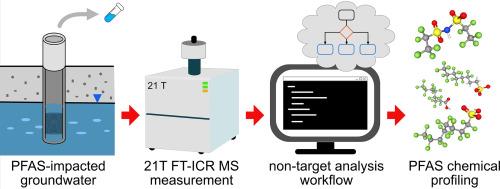Exploring the Fluorinome of PFAS-Impacted Groundwater Using 21 Tesla FT-ICR Mass Spectrometry
IF 12.4
1区 环境科学与生态学
Q1 ENGINEERING, ENVIRONMENTAL
引用次数: 0
Abstract
Non-targeted analysis of complex per- and polyfluoroalkyl substances (PFAS) via Fourier-transform ion cyclotron resonance mass spectrometry (FT-ICR MS) promises unprecedented insights into the “fluorinome”, i.e., the complete set of organofluorine compounds in a given sample. In this study, we present a Python-based workflow developed in parallel with a carefully constructed PFAS formula database comprising ∼ 20 million entries to facilitate the assignment of chemical formulas to ultrahigh-resolution mass spectra. PFAS assignments based on the analysis of complex aqueous film-forming foam (AFFF) on the world’s highest-resolving 21 tesla FT-ICR MS were compared to quadrupole time-of-flight (QTOF) MS data, validating 22 common and discovering 19 previously undetected PFAS classes. We then explored the viability of ultrahigh-resolution FT-ICR MS analysis for forensic profiling purposes on PFAS-impacted groundwater samples, identifying bis-perfluoroalkyl sulfonimides (bis-FASIs) as long-suspected ingredients of electrochemical fluorination AFFFs. While our newly developed workflow may also be used for other types of high-resolution mass spectrometers such as QTOF and Orbitrap, this work leverages the unique ultrahigh-resolving power, sub-ppm mass measurement accuracy, and high dynamic range of 21 tesla FT-ICR mass spectrometry to maximize information from complex contaminant mixtures in environmental samples.

利用21特斯拉FT-ICR质谱法研究pfas影响地下水的氟组学
通过傅里叶变换离子回旋共振质谱(FT-ICR MS)对复杂的单氟烷基和多氟烷基物质(PFAS)进行非靶向分析,有望前所未有地深入了解“氟组”,即给定样品中完整的有机氟化合物。在这项研究中,我们提出了一个基于python的工作流程,与一个精心构建的PFAS公式数据库并行开发,该数据库包含~ 2000万个条目,以促进化学公式与超高分辨率质谱的分配。在世界上分辨率最高的21特斯拉FT-ICR质谱上,基于复杂水成膜泡沫(AFFF)分析的PFAS分配与四极杆飞行时间(QTOF)质谱数据进行了比较,验证了22种常见的PFAS类别,发现了19种以前未检测到的PFAS类别。然后,我们探索了对pfas影响的地下水样本进行法医鉴定的超高分辨率FT-ICR MS分析的可行性,确定了双全氟烷基磺酰亚胺(bis-FASIs)作为电化学氟化afff的长期怀疑成分。虽然我们新开发的工作流程也可用于其他类型的高分辨率质谱仪,如QTOF和Orbitrap,但这项工作利用了21特斯拉FT-ICR质谱的独特超高分辨率,亚ppm质量测量精度和高动态范围,以最大限度地从环境样品中的复杂污染物混合物中获取信息。
本文章由计算机程序翻译,如有差异,请以英文原文为准。
求助全文
约1分钟内获得全文
求助全文
来源期刊

Water Research
环境科学-工程:环境
CiteScore
20.80
自引率
9.40%
发文量
1307
审稿时长
38 days
期刊介绍:
Water Research, along with its open access companion journal Water Research X, serves as a platform for publishing original research papers covering various aspects of the science and technology related to the anthropogenic water cycle, water quality, and its management worldwide. The audience targeted by the journal comprises biologists, chemical engineers, chemists, civil engineers, environmental engineers, limnologists, and microbiologists. The scope of the journal include:
•Treatment processes for water and wastewaters (municipal, agricultural, industrial, and on-site treatment), including resource recovery and residuals management;
•Urban hydrology including sewer systems, stormwater management, and green infrastructure;
•Drinking water treatment and distribution;
•Potable and non-potable water reuse;
•Sanitation, public health, and risk assessment;
•Anaerobic digestion, solid and hazardous waste management, including source characterization and the effects and control of leachates and gaseous emissions;
•Contaminants (chemical, microbial, anthropogenic particles such as nanoparticles or microplastics) and related water quality sensing, monitoring, fate, and assessment;
•Anthropogenic impacts on inland, tidal, coastal and urban waters, focusing on surface and ground waters, and point and non-point sources of pollution;
•Environmental restoration, linked to surface water, groundwater and groundwater remediation;
•Analysis of the interfaces between sediments and water, and between water and atmosphere, focusing specifically on anthropogenic impacts;
•Mathematical modelling, systems analysis, machine learning, and beneficial use of big data related to the anthropogenic water cycle;
•Socio-economic, policy, and regulations studies.
 求助内容:
求助内容: 应助结果提醒方式:
应助结果提醒方式:


